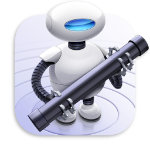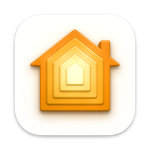If you desire to leverage the power of automation but don’t feel up to the challenge of scripting directly, then Apple and some third parties have it sorted for you. Automation apps work on the principal of stringing ‘actions’ together to achieve an end result. They are very powerful and built right into your Mac and iPhone.
This article focusses on automation apps. Check out Part 1: Simple Automation to find out how to leverage several standard tools built into MacOS’s GUI (Graphical User Interface). Part 2: Automation with Scripting delves into the various scripting languages available on the mac and focuses on building some useful tools.

Automator
Automator allows you to create flows for your Mac using a series of blocks that take the result of the block proceeding them and produce a result. This way it’s very easy to build a small program that performs a very specific function. Apple supplies a whole host of different options like selecting a group of files, or scaling and converting an image. When combined together, quite complex procedures can be created. It allows you to incorporate both a Shell script or AppleScript into the automation with the relevant block. I find it can be quite challenging to work out which blocks are required to perform a certain task, but once you have solved that aspect, the application comes together very quickly. You can save Automator flows as applications, a system service or a folder action amongst others which really offers a lot of flexibility in how it can be used. Its only real downside is that Automator is being depreciated in favour of the newer Shortcuts app, so no new blocks are actively being added, but for all of us still running an older system it’s an invaluable tool.
Adding a New Event to Calendar
Follow along with this video where we will use Automator to add the ability to create a new Calendar event without having to launch the Calendar app. Later we will create the same flow in Shortcuts which will demonstrate the advantages of the newer app.
If you would rather you can download it along with the other tools demonstrated in this article for free using the link at the top of this post.

Shortcuts
Shortcuts works in a similar fashion to Automator; it uses actions to create a flow which enables you to control MacOS and iOS as well as your installed applications in a variety of ways. It’s the successor to Automator and actually originated on iOS. One of the great things about Shortcuts is that you can get Siri to run the flow purely be saying the shortcut’s name, but you can also have them accessible from other locations, such as the menu bar or the Services menu. Another great aspect is the Gallery which is a collection of useful shortcuts that you may like to add to your set, or use as inspiration for creating/customising your own. There are also many ‘shortcuts’ available from developers across the web that can help you to expand your repertoire.
We are going to build several useful shortcuts that can be used in our everyday work, including restoring a feature that Apple has removed from the latest version of Pages (and the rest of the iWork Suite): the ability to share a copy of a document in a different format. Follow the videos to find out how to build them or use the link at the top of the page to download them for free.
Add a New Event to Calendar
We start with a simple shortcut to add a diary event from a keyboard shortcut no matter the application we are currently in. This introduces the core concepts of using Shortcuts and how much easier it is to create and use than the Automator equivalent.
You can follow along to create it yourself or download it along with the other tools demonstrated in this article for free using the link at the top of this post.
Email Pages as PDF
We are going to address the issue of the removed iWork feature, by first creating a shortcut that emails a PDF version of a Pages document. In the next video, below we will expand the shortcut we build here to be more fully featured.
Share pages as
Next we build the aforementioned ‘Share Pages as . . .’ shortcut that will take a pages document and convert it to our desired format before letting us share it (with airdrop, email, messages etc).
Creating a Project Folder Structure
Finally we build a shortcut that will create a folder structure for a new project at a specified location, saving time and making sure that we have a consistent design between projects. We also take a look at how we can add a simple project progression system using Finder Tags.

Home
The Home app is Apple’s solution for home automation. It’s where HomeKit compatible devices can be controlled and scenes created to control every aspect of your Smart devices in a simple way. With one press of a Scene (a collection of settings to contol each smart device in your home), all of the relevant changes are made. For say, ‘movie night’, the TV and sound bar turn on, the lights dim and the curtains are drawn. You can even assign the Scene to a phrase enabling you to use Siri to start it. The Home app is available on both iOS and MacOS and compatible with a wide array of Smart Home accessories.
Keyboard Maestro
Keyboard Maestro is a third party app that takes off where Automator finishes. It allows you to automate almost anything on the Mac, like text substitution, app launching, filling in webforms or/and downloading files. It comes with many actions that you can combine together that include flow control, conditions and looping. They offer a free trial so if you are interested in taking your automations to the next level, it’s well worth checking out.

Stream Deck
The Stream Deck is a customisable button array which allows you to assign an action (and icon) to a button for a single, physical press. It comes in several different sizes, and gives you the option to create folders for many diverse ‘pages’ of automations all at your fingertips. Many people like to use the Stream Deck in conjunction with Keyboard Maestro to truly customise their automation experience. There are many models in the range offering more or less buttons as well as dials and even a foot pedal.
We have come to the end of our series on Automation and have discovered many ways in which we can get our Macs, iPhones and iPads to do things for us that would be hard or repetitive any other way. Using automation, we can create highly personal and optimised workflows to help us achieve things faster and with less stress.
If you would like to discuss Automation and how it could be useful to you or your business then please do drop me an email.

